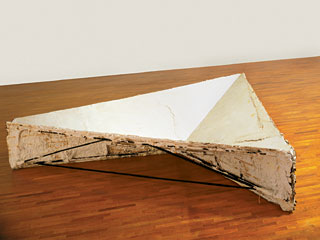|
| |
 |
|


|

Triangular Depression, 1977. Plaster, burlap, steel mesh, and steel rods, 21 x 121 x 103 inches. The Museum of Modern Art, New York, Gift of Werner and Elaine Dannheisser, 1996. Solomon R. Guggenheim Museum, New York, Fractional gift, Werner Division. 91.3901
|

Influenced by experimental and what is now termed "Minimal" dance, music, and film, Bruce Nauman, like many of his peers in the 1960s, expanded artistic practice and its reception by introducing performance strategies into his work. Nauman moved away from static, self-contained art objects to create an art of real experience by featuring his own body as sculptural material. He would repeat simple, often scripted actions that he called "dances" in front of the camera in his studio. In Manipulating a Fluorescent Tube Nauman manipulates a standard light fixture (what Dan Flavin used as a building block for his Minimalist sculptures) into various positions in relation to his own body. Such formal investigations acquired more psychological resonance in works such as Bouncing in the Corner, No.1, which depicts the artist falling backward repeatedly into a corner. Seen from the side and with his head cropped out of the frame, Nauman becomes an anonymous surrogate for the viewer, who is drawn into the rhythm and physical tension of the work.
Lighted Performance Box engenders another type of conceptual performance and foreshadows Nauman's later focus on sculpture and the performance of the viewer. Sculpture always has a performative aspect because, as Nauman once said, "the spectator has to walk around it. In that sense you become a participant or performer." Resembling the quintessential unitary Minimalist sculpture, the rectangular aluminum column holds within it a lamp that casts a light on the ceiling and simultaneously draws attention to the hollow interior of the box. The human scale of the box provokes the viewer to mentally project his or her body into the implied interior space.
Triangular Depression draws attention to a different kind of spatial volume. While the simple, raw form has a strong presence—with the process of its making cleary visible—it is the negative space delineated that is the focus of the work. The sculpture is an architectural model for a larger, unrealized project; in its intended state the triangle's outer edges would be at ground level and its midpoint below that level. This work is related to the artist's earlier casts, which also challenged notions of interior and exterior.
|
|